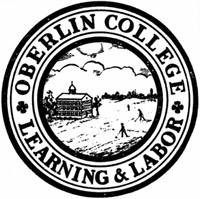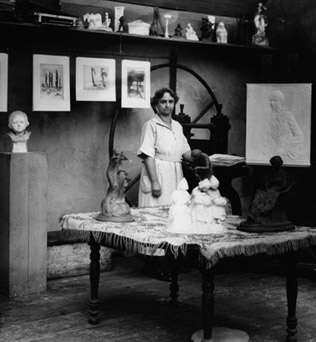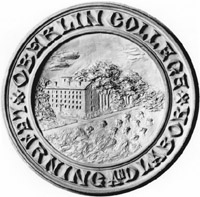Oberlin Public Art
Exhibit Contents
Julia Gridley Severance: "College Seal"
When Emily Peck exhibited her plaster model of the Gen. Shurtleff statue in Spear Library, it undoubtedly got close attention from one student who was to become an artist herself.
Four years earlier, in the summer of 1894, James Severance had escorted his wife and daughter from Chicago by boat to Cleveland and then by hired carriage for the trip to Oberlin. He and his wife had been students at the College and James had stayed to teach after graduating from the Seminary. Their daughter, Julia, had been born in Oberlin. James, mechanically gifted with a strong interest in agriculture, had invented harvesting machinery and had left the academic world to manufacture this equipment. He was returning to Oberlin a successful and astute businessman to succeed Gen. Shurtleff as Secretary-Treasurer of the College.
The Severances planned to build a new home on their property at 10 South Professor,1 had had the previous building on the lot removed, and were getting estimates for the erection of a new house. It was designed by a Chicago firm and was to be of stone. Dutch Colonial was and still is an unusual architectural style for Oberlin. The gambrel roof and the thick 18" walls of patterned stone set it apart from its predecessors on South Professor. It created discussion in the village, and the long sloping roof protecting a wide verandah prompted a local wit to place on the Severance lawn a sign reading: "This is not a railway station" The interior decoration too would be different. Instead of the current dark rich clutter of Victoriana, it would be light and airy with white painted walls banded with simple plain moldings. Cool blue Dutch tiles would form the hearth and surround the fireplace.
When the family arrived work had already begun on the barn at the rear of the property. The stone pattern for the house would be "tried out" over the rubble walls of this building until Mr. Severance was satisfied it was suitable. Like a simplified, smaller version of the house, it was to become within a few years something more than the barn for the Severance's carriage or Julia's motor-car. A structure at right angles to the south end was to be added with a skylighted roof for the favored northern light. Built-in cupboards would line the walls for tools and supplies. The center space between the studio and the carriage room would be given a fireplace with flanking benches. And the artist, for whom all this luxury was designed, would carve in the brick in curved art nouveau letters a friendly greeting to visitors.
The studio was more than indulgence to an only child. The Severances were proud of Julia and had encouraged her talents. She had studied at the Chicago Institute of Art, the Cleveland School of Art and had taken courses in the College's Department of Drawing and Painting. Eva M. Oakes had arrived in Oberlin the same year as the Severances to take charge of that department. A former Oberlin student, she had studied at the Art Students League in New York and intended giving the serious Oberlin art student adequate preparation to enter advanced courses at any good school. The Oberlin training was sufficient for Julia to later enter sculpture classes at the Art Students League. After further study in Italy she returned to her own studio, meticulous and confident in technique.
For more than 30 years it was a busy active place. It was here that she sculpted a small round-faced boy and little girl with long curls for Prof. and Mrs. Clarence Ward.2 She was particularly fond of children and made their portraits one of her specialties. It was here she held occasional exhibitions of her works: the series of Florida etchings that had been purchased by a New York hotel, the sculpture that had won first prize at the Cleveland Women's Art Club. It was here her book club gathered around the fireplace to read aloud Jane Austen. And here, her students from the modeling class at the Kindergarten Training School came for tea.
In 1910, the architect of Wilder Hall, J. L. Silsbee of Chicago, asked her to design a modern version of the College Seal in bas-relief as part of the decoration that would appear over the entrance to the assembly room (now, the first floor Main Lounge). She was to follow the College By-laws adopted in 1852 which restricted her to the circular form "with two enclosing circles displaying upon the enclosed field a representation of a field of grain with a College building, within the margin below, the motto, Learning and Labor, and in the margin above, the name of the College."
Within these limitations Julia transformed the 1852 Seal much as the College itself had altered. In the earlier seal a solitary Tappan Hall was set on newly cleared land being cultivated. In the new version the vulnerable [venerable] Hall is sheltered by a heavy stand of trees, while across the road, symbol of an established community, there is evidence of a bountiful harvest. She put the motto and college name in curved letters with sharp edges that cast strong deep shadows, particularly suitable to the high position for which the bas-relief was intended. The design was so well received that the trustees decided to adopt it as the Official Seal and Julia made a reduced version that is still in use. Other copies of the Wilder decoration were made, one of bronze for the president's office.
There were other commissions for works on campus, among them the Cobb and Rice memorials for the Conservatory.3 In 1926, she translated a group of her drawings of college buildings into etchings.4 Reproductions of these were made and issued as the College calendar of that year and the next. Subsequently, the etchings were reduced in size and printed on postcards and sold in the local bookstores. Years later, boxes of them were discovered, brown with age, in the basements of several of the West College buildings. Brought upstairs and placed next to modern color photographs of the campus, the Co-op generously marked them at a bargain five cents each. The last card was sold in the fall of 1975, more than a half century after Julia had made some of the original sketches.
She is remembered as kind and friendly, shy and reserved, a well-organized teacher, straightforward and sensible, gifted in many ways and a good friend. She is remembered in her 70's demonstrating her lack of stodgy aesthetics by seeing beauty in the descending rows of television antennae beneath her home on a San Diego hillside. She is remembered in her 80's setting off in a friend's jeep or the city bus to woodcarving lessons 20 miles away.
Julia Severance left Oberlin in 1940. Her beautiful studio still stands though it has never been used by any other artist. Her memorial bas-reliefs and an Oberlin Inn mural were long ago taken away, replaced by newer decoration. All that remains is her original Wilder decoration of the College Seal and the variations derived from it. Neither name nor initials of the artist appears on these. Such information is now limited to the files in the Archives office and the bound volumes of the Alumni Magazine.


